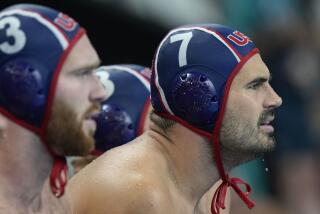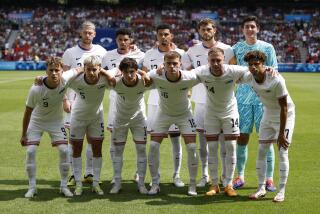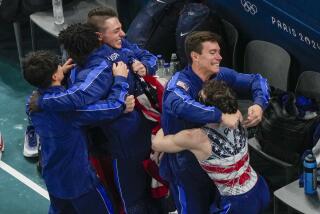A LOOK AT THE OTHER SPORTS...
Before the 1984 Olympics, the American judo team--an exuberant band of amateur roughnecks--had rashly promised to “make history.” They delivered.
In the wake of the American gold-medal flood, the world--or at least the U.S. public--may little note nor long remember the bronze and silver won by Ed Liddie and Bobby Berland, respectively.
In terms of U.S. judo, though, the medal count, which equalled America’s entire previous Olympic total, generated a momentum that is already accelerating on the road to Seoul in 1988.
Initially, and understandably, there was a letdown, a betrayal of ’84 promise:
--Monolithic 209-pounder Leo White had posted a stunning upset of Belgian world champ Robert Van de Walle, only to lose on a fancy, chancy footsweep to an obscure Icelander.
--Mike Swain (156), Doug Nelson (heavyweight) and Dewey Mitchell (open) all were victims of the new U.S. reputation: their opponents ran, hid and won on points.
--Brett Barron (172) dislocated a shoulder with a bronze in sight.
--Craig (Little Patton) Agena (143) dislocated everything.
That’s the bad news. The good news is that the U.S. team, minus only the battered Agena and the retired Mitchell, is back intact.
The good news, in detail: In June, the team made another bit of history. Bolstered by several veteran contenders--notably L.A.’s quiet, competent Kenny Patteson (172 pounds) and Chicago’s wily and wooly Steve Cohen (open)--the United States finished a close second in the prestigious Pacific Rim Tournament; 1988 Games host Korea, with five ’84 Olympic medalists, finished third.
Better news: With continuing USOC financing, America’s top-class judo players--provided they get time off from their jobs--will be spending more time at the Olympic Training Center in Colorado Springs, and will be making more trips to Europe and Asia, where the stiffest competition waits in ambush. America does not yet have sufficient domestic depth to make its competitors match-tough.
Realistic news: Whereas the budget of U.S. Judo Inc. (the governing body) has risen to $240,000 a year, Korea’s, for example, is $1 million, without the pressing need to travel.
“We need both to sustain our elite athletes and develop our kids from junior high up,” says Bruce Toups, USJI director of development, “but it’s tough to do both on a comparative shoestring.
“With no pro future in judo, we have to attract the truly dedicated, the ones who play strictly for the love of the sport and the honor of representing America.
“Still, just think of what I could do just with the salary of the Lakers’ third-string center (Mitch Kupchak). I could run the entire U.S. program on what he’s paid . . . “
Nevertheless, on a modest budget, the USJI has managed to create a competitive situation unique to American judo: a depth chart at least two deep, “and sometimes three,” says Toups. “Of course, they’re five, six, ten deep in the Orient, in Eastern Europe, in France, Canada, even Brazil.
“But for the first time, U.S. judo has a lovely situation: two Americans fighting in almost every division that we’d be just as happy regardless of who won. Patteson pushing Barron; Tommy Martin (of Fresno) pushing Berland; Steve Cohen (out of retirement after eight years) pushing everyone.”
As for women’s judo, even a better-kept secret than the men’s sport, the strong U.S. team is awaiting the forthcoming decision as to whether their sports will be included in the Seoul Olympics.
More to Read
Go beyond the scoreboard
Get the latest on L.A.'s teams in the daily Sports Report newsletter.
You may occasionally receive promotional content from the Los Angeles Times.






